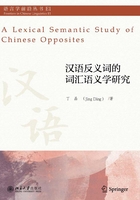
Abstract
Previous studies on opposites focused on its sub-type classification and such as antonym(or, gradable opposite),complementary(or, ungradable opposite)and converse(or, relational opposite)but are not enough to clarify the differences among the three sub-types. Besides, the behaviors of opposites in natural language has not been observed and discussed yet.Therefore, these two questions trigger our work on the topic of opposites.
With a large-scale corpus, this work focuses on Chinese opposites, a rela-tively poorly explored language in this area, as the experimental object, and has finished three studies on the behaviors of the three main sub-types, from charac-ter-based constructions to constrained-free contexts.
The first study focuses on the opposite pairings in constructions from bi-syl-labic to quad-syllabic. We discuss the semantic functions of these pairings under different structures.For practical usages and explore the determining principles in opposite member order.Our findings suggest that Pollyanna Principle is not enough to explain all the Chinese data.Prosodic principle and temporal order may influence the opposite order in constructions.
The second study is an extensional work of the first one. Syntactic frames are used to extract the opposite pairings'co-occurrence in discourse.Result of it shows the differences among the three sub-types of opposites in discourse func-tion distribution, and that among Chinese, English and Japanese.Moreover, we use frequency and frame distribution to define canonical opposite pairings and find that Chinese data challenges the hypothesis in previous researches.
In study 2,we notice that negation frames only take a small percentage in Chinese result. In order to see the relation between negation and opposites, we design study 3.We use negation frames to trigger out pairings in free-constrained context.Result clearly shows that, rather than opposites, other semantic relations also occur in these frames.It suggests that, words in negation frames are not necessary to be opposites.
In sum, the three studies cover the most discussed topics in previous studies about opposite relation. This work is meaningful in the theoretical discussion on semantic relations, as well as in the practical resource building for Information Extraction as general.